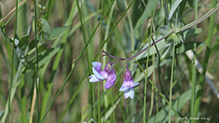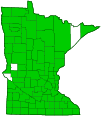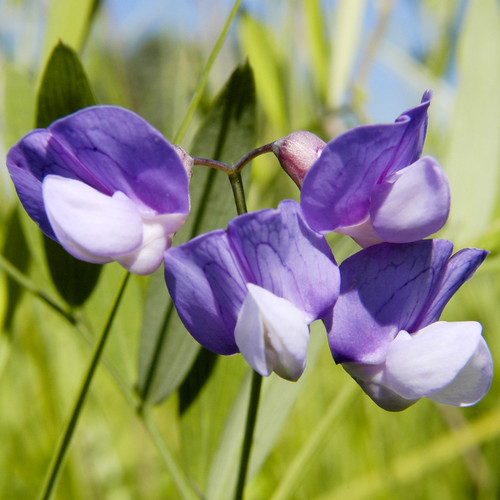marsh vetchling
(Lathyrus palustris)
Conservation • Wetland • Description • Habitat • Ecology • Use • Distribution • Taxonomy
Description |
||
Marsh vetchling is a perennial vine that rises from a slender underground stem (rhizome) and fibrous roots. The roots do not produce starchy swellings (tubers). The vine usually climbs over adjacent vegetation. In the absence of supporting vegetation, it creeps along the ground (trails). The stems are four angled, unbranched or few branched, and usually hairless, sometimes sparsely hairy. They are often distinctly winged, sometimes narrowly winged. Plants with unwinged but acutely ridged stems that have been called var. myrtifolius have been identified from New York through Wisconsin, but are not known to occur in Minnesota. The leaves are alternate, evenly pinnately divided usually 6, sometimes 4 or 8 leaflets with a tendril at the end. They are on unwinged, 5 ⁄16″ to 1 3 ⁄16″long stalks. The tendrils are mostly branched, though some of them may be unbranched. At the base of each leaf there is a pair of small, ½″ to 1″ long or longer, ⅛″ to ⅜″ wide or wider, leaf-like appendages (stipules). The stipules are narrow, asymmetrical, and two-lobed, shaped like an arrowhead split lengthwise. The upper lobe is longer than the basal lobe. They are sometimes shallowly and inconspicuously toothed. The leaflets are oppositely attached and their shape varies greatly. They are ¾″ to 2¾″ long and ⅛″ to ¾″ wide. They may be linear, narrowly elliptic, narrowly lance-shaped, or elliptic. They are angled at the base and sharply or bluntly pointed at the tip. The upper and lower surfaces are hairless. The margins are untoothed. The inflorescence is a loose, unbranched cluster (raceme) of usually 2 to 6, rarely up to 9 flowers rising on a long stalk from some of the leaf axils. The inflorescence stalk (peduncle) is 1 3 ⁄16″ to 2⅜″ long, about as long as the subtending leaf. The individual flowers are ½″ to ¾″ long and pea-like. They have 5 sepals, 5 petals, 10 stamens, and 1 style. The sepals are united into an ⅛″ long bell-shaped tube at the base then separated into 5 unequal, 1 ⁄32″ to ¼″ long lobes. The upper two lobes are short and triangular, the lowest one long and narrowly lance-shaped, the lateral two intermediate in both size and shape. The 5 petals are reddish-purple and are organized into a broad banner at the top, 2 wings, and a keel in the center formed by two petals fused together at the tip. The banner is egg-shaped to nearly circular and is strongly bent backward. The wings are broadly egg-shaped and are curved around and over the keel. The keel is boat-shaped, shorter than the wings, and curved upward. The flowers are sometimes bicolored, the banner reddish-purple with dark, highly contrasting veins, and the wings and keel white. The stamens have ½″ to 9 ⁄16″ long filaments. Nine of the filaments are fused to ⅜″ above the base, the tenth is free nearly to the base. The anthers are yellow. The fruit is a linear to narrowly oblong, flattened, 1 9 ⁄16″ to 2⅜″ long, ⅛″ to 3 ⁄16″ wide seed pod with 5 to 10 seeds. It is green at first, becoming reddish-brown to nearly black when ripe. |
||
Height |
||
Climbing, 12″ to 40″ long |
||
Flower Color |
||
Reddish-purple |
||
Similar Species |
||
| Veiny pea (Lathyrus venosus var. intonsus) stems are hairy and are not winged. The stipules are narrower, 1 ⁄32″ to ⅛″ wide, and are untoothed. The upper and lower lobes of the stipule are about the same length. The leaves have 8 to 14 leaflets. The leaflets are usually bluntly pointed at the tip. The racemes are dense and have 8 to 20 flowers. The corollas are pinkish-purple to lavender. | ||
Habitat |
||
Wet to moist. Wet prairies, sedge meadows, fens, swamps, marsh borders, streambanks. Full or partial sun. |
||
Ecology |
||
Flowering |
||
June to July |
||
Pests and Diseases |
||
|
||
Use |
||
|
||
Distribution |
||||
|
Sources |
|||
| 4/3/2023 | ||||
Nativity |
||||
Native |
||||
Occurrence |
||||
Common |
||||
Taxonomy |
|||
| Kingdom | Plantae (green algae and land plants) | ||
| Subkingdom | Viridiplantae (green plants) | ||
| Infrakingdom | Streptophyta (land plants and green algae) | ||
| Superdivision | Embryophyta (land plants) | ||
| Division | Tracheophyta (vascular plants) | ||
| Subdivision | Spermatophytina (seed plants) / Angiospermae (flowering plants) | ||
| Class | Magnoliopsida (flowering plants) | ||
| Superorder | Rosanae | ||
Order |
Fabales (legumes, milkworts, and allies) | ||
Family |
Fabaceae (legumes) | ||
| Subfamily | Faboideae | ||
| Tribe | Fabeae (peas, vetches, and allies) | ||
| Genus | Lathyrus (sweet peas and vetchlings) | ||
Subordinate Taxa |
|||
Several subspecies and/or varieties have been described based on amount of pubescence, leaflet width, and winged or unwinged stem. A study in 1998 (Isley) found that they intergrade completely and are not geographically or ecologically distinct, and therefore have no basis for separation. |
|||
Synonyms |
|||
Lathyrus myrtifolius Lathyrus palustris ssp. pilosus Lathyrus palustris var. linearifolius Lathyrus palustris var. macranthus Lathyrus palustris var. meridionalis Lathyrus palustris var. myrtifolius Lathyrus palustris var. pilosus Lathyrus palustris var. retusus Orobus myrtifolius |
|||
Common Names |
|||
marsh pea marsh vetchling |
|||
Glossary
Calyx
The group of outer floral leaves (sepals) below the petals, occasionally forming a tube.
Corolla
A collective name for all of the petals of a flower.
Filament
On plants: The thread-like stalk of a stamen which supports the anther. On Lepidoptera: One of a pair of long, thin, fleshy extensions extending from the thorax, and sometimes also from the abdomen, of a caterpillar.
Linear
Long, straight, and narrow, with more or less parallel sides, like a blade of grass.
Peduncle
In angiosperms, the stalk of a single flower or a flower cluster; in club mosses, the stalk of a strobilus or a group of strobili.
Pinnate
On a compound leaf, having the leaflets arranged on opposite sides of a common stalk. On a bryophyte, having branches evenly arranged on opposite sides of a stem.
Raceme
An unbranched, elongated inflorescence with stalked flowers. The flowers mature from the bottom up.
Rhizome
A horizontal, usually underground stem. It serves as a reproductive structure, producing roots below and shoots above at the nodes.
Sepal
An outer floral leaf, usually green but sometimes colored, at the base of a flower.
Stipule
A small, leaf-like, scale-like, glandular, or rarely spiny appendage found at the base of a leaf stalk, usually occurring in pairs and usually dropping soon.
Trailing
Prostrate on the ground and creeping, but not rooting at the tip.
Tuber
An underground root (as with dahlias) or stem (as with potatoes), thickened by the accumulation of reserved food (usually starch), which serves for food storage and vegetative propagation.
Visitor Photos |
|||||
Share your photo of this plant. |
|||||
| This button not working for you? Simply email us at info@MinnesotaSeasons.com. Attach one or more photos and, if you like, a caption. |
|||||
Dan W. Andree |
|||||
Prairie Wild Flower… Seen this flower today on a Prairie in Norman Co. Mn. I tried finding out what it is but couldn’t find it. It was growing in a moist area. Kind of reminded me of a pea flower that blooms before you get peas. But I am sure it isn’t maybe some wild type pea plant. But I have no clue. It seemed to have little extensions that curled around other plants to help support it. Kind of like pea plants do. Anyway maybe you know what this is. |
 |
||||
MinnesotaSeasons.com Photos |
|||||
|
|||||

Visitor Videos |
|||
Share your video of this plant. |
|||
| This button not working for you? Simply email us at info@MinnesotaSeasons.com. Attach a video, a YouTube link, or a cloud storage link. |
|||
Other Videos |
|||

Visitor Sightings |
|||||
Report a sighting of this plant. |
|||||
| This button not working for you? Simply email us at info@MinnesotaSeasons.com. Be sure to include a location. |
|||||
| Dan W. Andree 6/8/2023 |
Location: Norman Co. Mn Seen this flower today on a Prairie in Norman Co. Mn. I tried finding out what it is but couldn’t find it. It was growing in a moist area. Kind of reminded me of a pea flower that blooms before you get peas. But I am sure it isn’t maybe some wild type pea plant. But I have no clue. It seemed to have little extensions that curled around other plants to help support it. Kind of like pea plants do. Anyway maybe you know what this is. |
 |
|||
MinnesotaSeasons.com Sightings |
|||||

|
Created: Last Updated: © MinnesotaSeasons.com. All rights reserved. |


